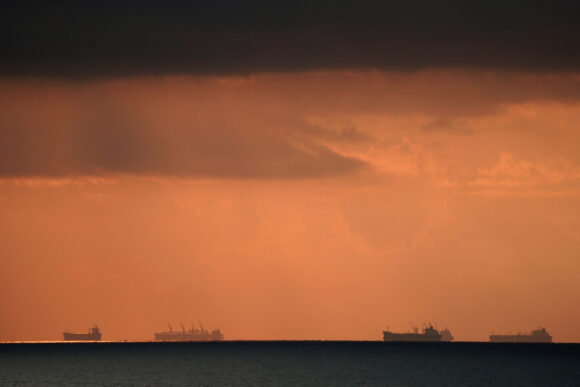A collision that set two vessels ablaze off Singapore has underlined the growing risks in the crowded Straits of Malacca, as the dark fleet expands and lackluster Chinese demand leaves dozens of the tankers idling.
The Ceres I, a 23-year-old crude oil tanker sailing under the flag of Sao Tome & Principe, and the Hafnia Nile, a Singapore-flagged refined-products tanker, crashed early Friday morning in one of the world’s busiest waterways. Ceres I then fled the scene with two tugboats, before being intercepted off Malaysia.
The incident ended without tragedy, with both crews accounted for and limited environmental damage. But the likelihood of a different outcome is rising — not only because more uninsured, aging vessels are passing through the straits, but because dozens of these ships are circling in the same waters. Their transponders are often switched on and off, making their movements harder to track.
Fire-Hit Tanker Enters Malaysia Terminal Area After Being Detained by Coast Guard
Currently, there is a cluster of about 30 aging tankers east of Malaysia, all bearing the hallmarks of shadow-fleet vessels. Built at least two decades ago, many may find it difficult to access ports because of the pollution risk. For more than two-thirds of these carriers, no insurer is identified on international shipping databases.
The waters east of Malaysia, the trade lane connecting Asia to the world’s major petroleum exporters, have long been a hot spot for dark fleet activity. Clandestine ship-to-ship transfers of oil from one vessel to another are regularly carried out to obscure the origin of shipments. Vessels also tend to wait in the calm waters between assignments or when demand slows.
But the number of older tankers in that cohort has increased significantly over recent years as Western sanctions prompt Iran, Russia and Venezuela to find alternatives to mainstream vessels and service providers.
While the current flotilla is not at its largest size for the year when compared to recent months, its existence and persistence is indicative of the increasing congestion in the straits. A majority are very large crude carriers or VLCCs — the industry’s biggest class of oil tankers — according to data compiled by Bloomberg. And a third are close to full based on their depths in the water.
Shipbrokers said the freight market for dark-fleet vessels has softened in recent weeks due to an oversupply of the ships.
The 30 idling carriers are part of a larger group totaling almost 50 anchored in that area. The others newer, although most of them were built in the 2000s and sailing with unknown insurers.
Singapore and Malaysia have both had several oil warnings of late. Last year, an explosion on board the aging oil tanker Pablo ripped off its deck like a sardine can and began a fire that sent dark plumes of smoke into the sky. Had it been laden with its most recent cargo, that would have been a major spill of oil sanctioned by the US. A minor collision in Singapore’s port last month created its worst oil spill in over a decade.
Photograph: Tankers are seen in Balikpapan, Borneo, Indonesia, on Tuesday, Nov. 26, 2019. Photo credit: Dimas Ardian/Bloomberg
Related:
- Russian Tactics Make Secret Tanker Oil Switching Harder to Trace
- Shadow-Fleet Oil Tanker Runs Aground Near Singapore
Was this article valuable?
Here are more articles you may enjoy.



 Progressive Q2 Net Income Skyrockets Over 320%
Progressive Q2 Net Income Skyrockets Over 320%  Viewpoint: Deepfake Fraud Is On the Rise. Here’s How Insurers Can Respond
Viewpoint: Deepfake Fraud Is On the Rise. Here’s How Insurers Can Respond  Soccer Officials Arrested After Melee That Damaged Hard Rock Stadium in Miami
Soccer Officials Arrested After Melee That Damaged Hard Rock Stadium in Miami  FM Global Rebrands As FM
FM Global Rebrands As FM 

